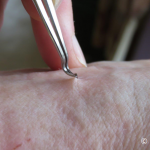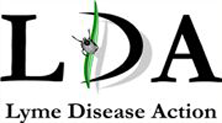Lyme Basics
Bitten by a Tick?
Lyme FAQ
Public Support
Clinician Resources
Media Enquiry
Patient Resources
Be Aware!If you are aware of ticks you are less likely to be infected by a tick-borne disease. Where will you find them? Gardens, parks and countryside – wherever there is vegetation to protect them from drying out; and where there are small animals, like mice, on which to feed. How do they find us?! They smell us, and hook onto us when we pass close to them. They climb up our legs and find some exposed skin to latch on to. How do they bite? They stick their toothed mouthparts into our skin, and numb the area so we don’t feel them.  They stay firmly attached for days while feeding on our blood. The best way to find an attached tick? Run your fingers over your skin. If you feel a small scab, see if it rocks back and forward. Look closely and you may see some legs, but they are very small. They stay firmly attached for days while feeding on our blood. The best way to find an attached tick? Run your fingers over your skin. If you feel a small scab, see if it rocks back and forward. Look closely and you may see some legs, but they are very small.  How to remove a tick? With a tick remover which doesn’t squash the body. Do it as soon as you can because the longer the tick is attached, the more likely it is to pass on any disease that it carries. What then? Make a note of the date you removed the tick. Read our website, in particular the page on Lyme disease symptoms so you know what to be aware of. How to remove a tick? With a tick remover which doesn’t squash the body. Do it as soon as you can because the longer the tick is attached, the more likely it is to pass on any disease that it carries. What then? Make a note of the date you removed the tick. Read our website, in particular the page on Lyme disease symptoms so you know what to be aware of.
Very few UK ticks carry Lyme disease, but awareness is key!
| Reality checkWe all read things on-line or in the press and wonder “is this true?” . . . “have they got this right?”. We have put some of the questions we are often asked on our Reality Check page.
Questions about tests for Lyme disease:
- are private ones better than NHS ones?
- what about those overseas labs?
Tick-borne infections – there is a lot on-line about people “with Lyme and co-infections”.
- What are these co-infections?
- Can I catch them in the UK?
And Lyme disease itself:
- Is it sexually transmitted?
- Why do they record more cases in Europe than here in the UK?
Lyme disease is complicated and we don’t know everything there is to know, but some aspects have been well researched and there are at least some answers. Have a read of our Reality Check page, and if you have other questions, then contact us. We have a large library of scientific papers and we fact check all our information carefully.
|
What we do
We are a charity dealing with Lyme disease throughout the UK. We provide accredited information that you can trust; for the public, patients and health professionals.
Find out the facts here on
We raise awareness, provide free leaflets and lobby for improved services. See our latest news items. We usually hold an annual conference. See the LDA conferences page for details of our conferences.
LDA Twitter Feed

 They stay firmly attached for days while feeding on our blood. The best way to find an attached tick? Run your fingers over your skin. If you feel a small scab, see if it rocks back and forward. Look closely and you may see some legs, but they are very small.
They stay firmly attached for days while feeding on our blood. The best way to find an attached tick? Run your fingers over your skin. If you feel a small scab, see if it rocks back and forward. Look closely and you may see some legs, but they are very small.  How to remove a tick? With a
How to remove a tick? With a  Printer Friendly
Printer Friendly